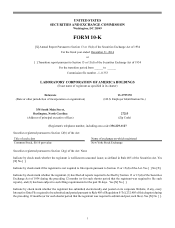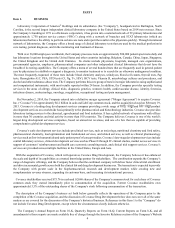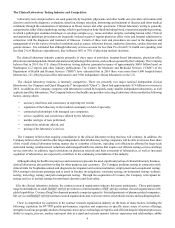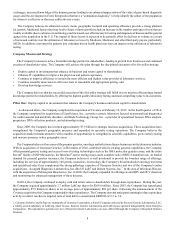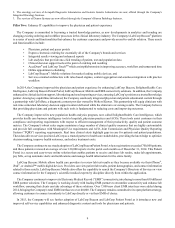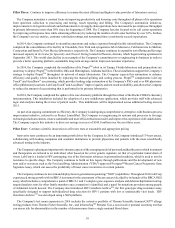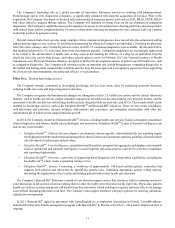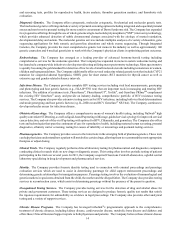LabCorp 2014 Annual Report Download - page 9
Download and view the complete annual report
Please find page 9 of the 2014 LabCorp annual report below. You can navigate through the pages in the report by either clicking on the pages listed below, or by using the keyword search tool below to find specific information within the annual report.
7
to manage lar clinical trials both domestically and internationally; quality of facilities; expertise and experience in
reimbursement and healthcare consulting; and size. The Company believes that Covance Drug Development competes favorably
in these areas and that the combined company will continue to compete favorably, including with respect to the strategic
opportunities discussed below under Integration Strategy.
Effect of Market Changes on the Clinical Laboratory Business
In connection with significant changes to health care, the clinical laboratory business is also undergoing significant change.
Medicare (which principally serves patients 65 and older), Medicaid (which principally services low-income patients) and insurers
have increased their efforts to control the cost, utilization and delivery of health care services. Measures to regulate health care
delivery in general and clinical laboratories in particular have resulted in reduced prices, added costs and decreased utilization for
the clinical laboratory industry by increasing complexity and adding new regulatory and administrative requirements. From time
to time, Congress has also considered changes to the Medicare fee schedules, and the Company believes that pressure to reduce
government reimbursement will continue. In March 2010, comprehensive health care reform legislation, the Patient Protection
and Affordable Care Act (“ACA”), was enacted. Among its provisions were reductions in the Medicare clinical laboratory fee
schedule updates, one of which is a permanent reduction and the other of which applies from 2011 through 2015. On February
17, 2012, Congress passed legislation that reduced payment rates under the Medicare Clinical Laboratory Fee Schedule ("CLFS")
by 2%, effective January 1, 2013. This reduction was applied after the adjustment of the fee schedule by the annual CPI update
as reduced by the productivity adjustment (0.9%) and the 1.75% reduction under the ACA, and before the scheduled 2%
sequestration reduction mandated by the Budget Control Act of 2011, which became effective April 1, 2013. The 2% sequestration
reduction applied to both the CLFS, which represented approximately 11.7% of the Company's revenue in 2013, and the Physician
Fee Schedule ("PFS"), which represented approximately 1.1% of the Company's revenue in 2013. During 2013, the Company
also experienced significant payment reductions to certain surgical pathology procedures and a variety of other government
reimbursement reductions. During 2014, the Company experienced a $6.0 million reduction in revenue as a result of a 0.75%
adjustment to the CLFS. Reimbursement to physicians under the PFS (which includes certain payments to diagnostic laboratories)
was also reduced, resulting in a $6.6 million payment reduction to the Company. During 2015, the Company faces a 0.25%
payment reduction to the CLFS and an estimated $2.1 million payment increase to the PFS, assuming the conversion factor remains
constant throughout 2015. The PFS assigns relative value units to each procedure or service and a conversion factor is applied to
calculate the reimbursement. The conversion factor will decrease by 21.2% on April 1, 2015 due to the Sustainable Growth Rate
formula, which would result in a 21.2% payment reduction to the PFS unless Congress acts to prevent the cut, as it has acted to
prevent similar cuts for the past decade.
On April 1, 2014, President Obama signed into law the Protecting Access to Medicare Act ("PAMA"), which included provisions
to reform the CLFS. Under PAMA, CMS will have no authority to make CLFS adjustments based on technological changes, as
CMS had proposed through rulemaking in 2013, and the annual CPI adjustments and the productivity adjustments to the CLFS
enacted under the ACA will no longer apply beginning in 2017. However, beginning in 2016, applicable laboratories will be
required to report private market data to CMS that CMS will use to calculate weighted median prices that will represent the new
CLFS rates beginning in 2017, subject to certain phase-in limits. For 2017-2019, a test price (based on applicable CPT codes)
cannot be reduced by more than 10% per year; for 2020-2022, a test price (based on applicable CPT codes) cannot be reduced by
more than 15.0% per year. Reporting and pricing will occur every three years, or annually with respect to certain types of tests,
to update the CLFS thereafter.
In addition, there are continuing market-based changes in the clinical laboratory business as diagnostic testing continues to
shift away from traditional, fee-for-service medicine to managed care. The growth of the managed care sector and consolidation
of managed care companies present various challenges and opportunities to the Company and other clinical laboratories. In 2006,
the Company signed a ten-year agreement with UnitedHealthcare® to become its exclusive national laboratory. This agreement
represented an industry first in terms of its length and exclusivity at a national level. In September 2011, the Company extended
this agreement for an additional two years through the end of 2018. The various managed care organizations (“MCOs”) have
different contracting philosophies, which are influenced by the design of their products. Some MCOs contract with a limited
number of clinical laboratories and engage in direct negotiation of rates. Other MCOs adopt broader networks with generally
uniform fee structures for participating clinical laboratories. In addition, some MCOs use capitation to fix the cost of laboratory
testing services for their enrollees. Under a capitated reimbursement mechanism, the clinical laboratory and the MCO agree to a
per member, per month payment for all authorized laboratory tests ordered during the month, regardless of the number or cost of
the tests performed. For the year ended December 31, 2014, capitated contracts with MCOs accounted for approximately $211.1
million, or 3.5% of the Company’s net sales. The Company's ability to attract and retain managed care clients will become even
more important as the impact of various health care reform initiatives continue, including expanded Health Insurance Exchanges
and Accountable Care Organizations ("ACOs" or "ACO").
Despite the potential market changes discussed above, the Company believes that the volume of clinical laboratory testing
will be positively influenced by several factors, including an expansion of Medicaid, managed care, and private insurance



